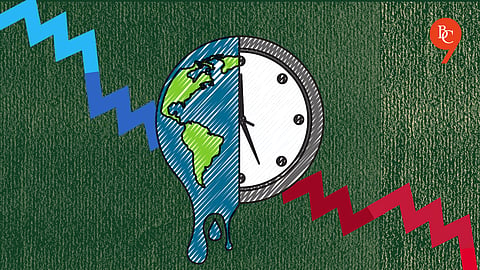

2020 was like something out of a dystopian novel, wasn't it? Along with a lockdown induced by a global epidemic that took the lives of more than 4.5 million people, the world witnessed several record-breaking disasters: a cold wave crippling the state of Texas, wildfires lashing out across five million acres of Amazon rainforest, Vietnam drowning in nine heavy storms and Cyclone Amphan rampaging through the border region of India and Bangladesh, to name same.
Now, scientists at United Nations University - Institute for Environment and Human Security (UNU-EHS) have concluded that all disasters are interconnected with each other. The new report, Interconnected Disaster Risks 2020/2021, analysed 10 disasters from 2020-21 and found that even though they occurred in vastly different locations and did not initially appear to have much in common, they were interconnected with each other.
As shown by the key findings of the recent IPCC Sixth Assessment Report, extreme events, such as droughts, fires and floods, are increasingly compounding each other, likely as a consequence of human influence. Viewed through a lens of interconnectivity, this new report shows in detail how not only climate disasters, but human-made disasters in general build on the impacts of the past and pave the way for future disasters. By analysing past disaster events through the lens of interconnectivity, both current and future disasters can be better understood.
"When people see disasters in the news, they often seem far away," said UNU-EHS Senior Scientist Zita Sebesvari, a lead author of the report, to IANS. "But even disasters that occur thousands of kilometres apart are often related to one another and can have consequences for people living in distant places."
Let's recall the recent heatwave in the Arctic while Texas experienced typical Arctic temperatures. 2020 witnessed the Arctic encountering the second-highest temperatures and second-lowest amount of sea ice cover on record. The increasing temperature in the Arctic destabilized the polar vortex which allowed the cold air to penetrate southward into Texas, a state that is used to year-round warm weather. The state's inexperience with handling a never-seen-before weather change saw the death of 210 people and the freezing of power grids which left four million people without electricity.
Disasters also often compound each other. The simultaneous occurrence of the COVID-19 pandemic and Cyclone Amphan in the border region of India and Bangladesh is an example. Due to the pandemic-induced lockdown, migrant workers were forced to return to their hometowns and were housed in cyclone shelters while under quarantine. When the region was then hit by Cyclone Amphan, many people, concerned over social distancing, hygiene and privacy, avoided evacuating to shelters and weathered out the storm in unsecured locations.
The "super" cyclone destroyed health centres in the region, resulting in the aggravation of the pandemic response and COVID-19 cases spiked in some areas. Keeping aside the impact the cyclone had on pandemic response, Amphan itself caused over 100 fatalities, damages in excess of $13 billion and displaced 4.9 million people.
Oftentimes, disasters stem from the same root causes. The new report Interconnected Disaster Risks identifies three root causes that affected most of the events in the analysis: human-induced greenhouse gas emissions, insufficient disaster risk management and undervaluing environmental costs and benefits in decision-making.
Human-induced greenhouse gas emissions were one of the reasons why Texas experienced the freezing temperatures, but they also contribute to the formation of super cyclones such as Amphan, for example -- an entirely different disaster in an entirely different part of the world.
Insufficient disaster risk management was one of the reasons why Texas experienced such high losses of life and excessive infrastructure damages during the cold wave, and the same also contributed to the high losses caused by the Central Vietnam floods.
The report also states that disasters are not only connected to each other but are also connected to us as individuals. The record rate of deforestation and wildfires in the Amazon is in part due to the high global demand for meat: farmland is needed to grow soy, which is used as animal fodder for poultry. "What we can learn from this report is that disasters we see happening around the world are much more interconnected than we may realize, and they are also connected to individual behavior. Our actions have consequences, for all of us," said fellow lead author Jack O'Connor. "But the good news is that if the problems are connected, so are the solutions."
The report showcases solutions at both the societal and individual level and explains how one action, such as cutting our greenhouse gas emissions, can affect many different types of disasters: it can prevent a further increase in the frequency and severity of hazards and protect biodiversity and ecosystems.
(With inputs from IANS)
